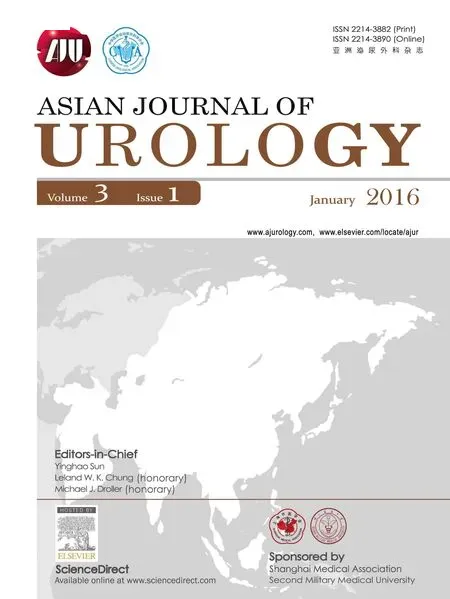
2016年1期
刊物介绍
上海市科学技术协会和中国人民解放军第二军医大学共同主办的全英文OA期刊Asian Journal of Urology, AJU(《亚洲泌尿外科杂志(英文)》)已于2014年10月上线( science/journal/22143882 ),CN31-2124,季刊。AJU由世界第一大科技出版社Elsevier生产与推广,执行严格的同行评议,在ScienceDirect全文发布,供全球读者免费下载阅读。目前已被ESCI、Scopus、DOAJ和EMBASE收录。br AJU编委会由82位专家组成,其中海外编委占81.7%。主编孙颖浩院士现任亚洲泌尿外科学会主席、中华医学会泌尿外科学分会主任委员,是第二军医大学校长兼全军前列腺疾病研究所所长、973首席科学家、何梁何利基金获得者,在泌尿外科领域具有较高的国际影响力。期刊荣誉主编LelandW. K. Chung教授还任American Journal of Cancer Research和American Journal of Translational Research期刊编委;荣誉主编MichaelJ. Droller教授同时还任Urologic Oncology期刊主编及Journal of Urology期刊副主编。8位副主编也均有丰富的办刊经验,多有担任国际性科技期刊编委经历,他们为AJU的发展提供了重要的信息和建议。67位国际编委,均为各国/地区泌尿外科学会主要成员;15位国内专家,也均在中华医学会泌尿外科学分会及各地方学会任重要职务,临床、科研资源丰富,具有较大的学术影响力。 br AJU涉及泌尿外科基础研究、临床研究及政策解读等各个方面。覆盖泌尿系肿瘤、腔道泌尿外科、泌尿系结石、女性泌尿外科、男科学、小儿泌尿外科、肾移植、不育等泌尿外科学的各个领域。栏目设置有Original articles, Reviews, mini-reviews, Clinical experience, Clinical images, Editorials, Rapid communications, Research highlights, Perspectives, Commentaries, Case reports, Letters, Asian focus, Urological data, News and information等,其中亚洲聚焦栏目(Asian focus)为本刊特色,着重报道亚洲地区泌尿外科学的研究成果、指南解读、卫生政策等,突出亚洲特色。 br AJU立足亚洲,面向世界,秉承“合作·交流·融合·创新”的办刊思路,以“国际化、高水平英文期刊”为办刊目标,旨在反映亚洲乃至世界范围内泌尿外科领域研究新进展、新成果和新技术,促进该领域的国内外交流,提高我国在该领域的科研技术水平和国际影响力,促进亚洲及全球泌尿外科学不断进步、发展,推动创新研究成果不断转化应用,造福人类。
Asian Journal of Urology
RESEARCH HIGHLIGHT
ORIGINAL ARTICLE
- Elevated preoperative neutrophil-tolymphocyte ratio may be associated with decreased overall survival in patients with metastatic clear cell renal cell carcinoma undergoing cytoreductive nephrectomy
- Prostate cancer volume associates with preoperative plasma levels of testosterone that independently predicts high grade tumours which show low densities(quotient testosterone/tumour volume)
- Zoledronic acid combined with androgendeprivation therapy may prolong time to castration-resistant prostate cancer in hormone-naïve metastatic prostate cancer patients-A propensity scoring approach
- Can intravesical prostatic protrusion predict bladder outlet obstruction even in men with good flow?
- Who needs further evaluations to diagnose upper urinary tract urothelial cancers among patients with abnormal findings by enhanced CT?
